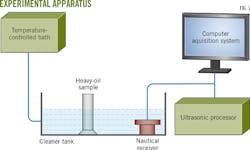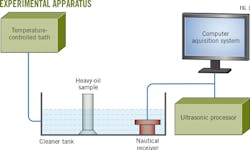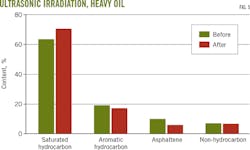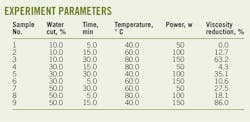Hua Qiang
Tan Donghan
Chen Laicheng
Puyang Institute of Technology, Henan University
Puyang, China
Tian Shicheng
China University of Geosciences
Beijing
Hu Yongle
PetroChina Research Institute of Petroleum Exploration & Development
Beijing
Experiments using heavy crude oil samples from PetroChina's Shengli oil field show ultrasonic irradiation can reduce viscosity by up to 85%, enhancing oil recovery. Increasing production from the aging Shengli field is difficult because of its 90% water cut.
Heavy oil production worldwide remains constrained because of resistance to flow, resulting from its high-molecular weight and heavy components such as asphaltene.
These same characteristics mean that heavy oil needs thermal or chemical activation. Researchers for this article investigated how ultrasonic waves change viscosity through cavitation, mechanical effect, and thermal effect and determined optimal ultrasonic treatment.
Heavy oil flow characteristics determine ultrasonic parameters for achieving maximum viscosity reduction. Ultrasonic irradiation affected paraffinic quantity, size, and shape.
Many Chinese oil fields feature a water cut of 80-90%. Ultrasound irradiation can decrease heavy oil viscosity within this water-cut range. Cavitation can break long carbon chains, enabling asphaltene decomposition. Ultrasonic waves influence paraffin crystal quantity, magnitude, and distribution.
Conventional viscosity-reduction by heating and use of a viscosity depressant is expensive and sometimes inefficient, making it unsuitable. Ultrasonic irradiation combined with a viscosity depressant, however, work synergistically to improve production.
Industry requires clean, effective, and economical methods to reduce heavy oil viscosity for both operational and environmental reasons. Ultrasonic waves decrease interfacial forces between oil and water, which can improve oil recovery rates.1-3 Ultrasonic waves also effectively treat petroleum-contaminated soils.4-6
This article examines ultrasound's effect on the quantity, magnitude, and distribution of paraffin crystals. Most previous studies focused on different ultrasound parameters, including ultrasonic frequency, ultrasonic power, and treatment time on heavy oil.7
Orthogonal experiments
Researchers calculated ultrasonic-induced viscosity reduction using orthogonal experiments designed to independently evaluate an individual factor among numerous factors, including ultrasonic frequency, ultrasonic power, and treatment temperature. Failure to control these parameters can generate incorrect conclusions.
Fig. 1 shows a diagram of the experimental apparatus, including a programmable rheometer, a temperature-controlled bath, ultrasonic processor, and computer. An ultrasonic generator supplied both ultrasonic waves at 20,000 hz and power (50, 100, 150 w) to a water bath. The rheometer determined viscosity of fluids at various temperatures.
Testers prepared Shengli oil samples having different water cuts and temperatures using the temperature-controlled bath. Samples were irradiated at intervals and various power outputs. Testers measured viscosity, calculated viscosity reduction, and ran the experiments three times to ensure repeatability.
Treatment time was 5 min, 15 min, and 30 min. Treatment longer than 30 min failed to further reduce viscosity. Treatment temperatures of 40° C., 60° C., and 80° C. were chosen. Researchers used water cuts of 10%, 30%, and 50%.
The table shows how exposure to ultrasonic waves of varying frequencies and powers, as well as differing crude water cuts and treatment temperatures, affect viscosity reduction.
Maximum viscosity reduction occurred with 15 min of irradiation at 40° C., 150 w, and water cut of 50%. This combination reduced viscosity by as much as 86%.
Ultrasonic irradiation decreased paraffin crystals' ease of distribution in crude oil colloidal structures. Irradiation also reduced paraffin crystals' size, augmenting viscosity reduction.
Scanning electron microscopy allowed laboratory observation of paraffin crystal morphology under ultrasonic irradiation. Fig. 2 shows paraffin crystals before and after ultrasonic irradiation.
Dehydrated heavy crude oil samples were exposed to ultrasonic irradiation of 150 w at 25° C. for 30 min. Dehydrated samples enabled investigation of the ultrasound's effect on paraffin crystal morphology. Jelly molecules between paraffin crystals inhibit the crystals' accumulation, preventing increased heavy oil viscosity over time.
Fig. 3 shows 150-w decreased paraffin crystals size compared with 50-w. Smaller crystal size enables wider distribution when exposed to ultrasonic irradiation.
Authors attributed viscosity changes to changes in crystals size, shape, and distribution.
Most paraffin crystals exhibited a three-dimensional structure but some appeared as large flakes. The three-dimensional structure contributed to high viscosity. Crystals responded differently to varying ultrasonic intervals.
Fig. 4 shows paraffin crystals assembled densely in irradiated heavy crude oil with 20% and 60% water cuts. Some crystals took the shape of slivers while changing from ellipsoid form to a globular shape.
In irradiated oil samples having a 60% water cut, paraffin crystals distributed more evenly and took on a globular shape. Paraffin crystals were bigger in the heavy crude oil with a 20% water cut than the 60% water cut. Irradiated heavy crude oil samples having a 60% water cut showed better flow characteristics than before treatment.
In reducing crude oil viscosity, ultrasound with certain parameters can stimulate minute bubbles which move, expand, contract, and vanish. The collapse of numerous cavitation bubbles generates high temperatures and high pressure.
Extremely heavy fuel oil cracks and lightens under ultrasonic treatment. Cracking and lightening of heavy crude oil decreases viscosity and improves flow. Boundary friction generates a thermal effect with quick temperature increases in heavy oil, which has a higher absorption coefficient than light hydrocarbons.
Researchers observed temperature rises of up to 10° C. in oil samples following ultrasound wave exposure. The pour point decreased to 37° C. from 45° C. after irradiation.
Irradiation
Fig. 5 shows how ultrasonic irradiation changed crude oil components. The content of non-hydrocarbon samples after 30 min of irradiation at 150 w resembled results for non-irradiated samples.
The content of aromatic hydrocarbons decreased to 17.17% after irradiation. Non-irradiated samples had 19.22%. The content of saturated hydrocarbons increased to 70.71% after irradiation from an untreated 63.45%. The asphaltene content decreased to 5.96% from 10.16% after irradiation. Cavitation can break a long carbon chain, allowing for decomposition of asphaltene and other high-molecular components when irradiated.
Experiments investigated how a combination of ultrasonic wave and viscosity depression affected viscosity reduction. Fig. 6 shows that combined use of viscosity depressant and ultrasonic treatment reduced viscosity by about 14% more than irradiation alone or ultrasonic treatment alone.
Acknowledgments
The Research Excellence Fund partially financed this research. Puyang Institute of Technology at Henan University provided financial assistance and hosted the experiments.
References
1. Hamida, T., and Babadagli, T., "Effects of ultrasonic waves on the interfacial forces between oil and water," Ultrasonics Sonochemistry, Vol. 15, No. 4, April 2008, pp. 274-278.
2. Hamidi, H., Mohammadian, E., Junin, R., Rafati, R., Manan, M., Azdarpour, A., and Junid, M., "A technique for evaluating the oil, heavy-oil viscosity changes under ultrasound in a simulated porous medium," Ultrasonics, Vol. 54, No. 2, February 2014, pp. 655-662.
3. Mousavi, S., Ramazani, A., Najafi, I., and Davachi S., "Effect of ultrasonic irradiation on rheological properties of asphaltenic crude oils," Petroleum Science, Vol. 19, No. 1, March 2012, pp. 82-88.
4. Mullakaev, M., Volkova, G., and Gradov, O., "Effect of ultrasound on the viscosity-temperature properties of crude oils of various compositions," Theoretical Foundations of Chemical Engineering. Vol. 49, No. 3, March 2015, pp. 287-296.
5. Hu, G., Li, J., Huang, S., and Li, Y., "Oil recovery from petroleum sludge through ultrasonic assisted solvent extraction," International Conference on Environmental Pollution and Remediation, Prague, Aug. 11-13, 2014.
6. Okparanma, R., Coulon, F., and Mouazen, A., "Analysis of petroleum-contaminated soils by diffuse reflectance spectroscopy and sequential ultrasonic solvent extraction-gas chromatography," Environmental Pollution, Vol. 184, No. 1, January 2014, pp. 298-305.
7. Li, J., Song, X., Hu G., and Thring R. "Ultrasonic desorption of petroleum hydrocarbons from crude oil contaminated soils," Journal of Environmental Science and Health, Part A, Toxic-Hazardous Substances & Environmental Engineering, Vol. 48, No. 11, September 2013, pp. 1378-1389.
8. Antes, F., Diehl, L., Pereira, J., Guimaraes, R., Guarnieri, R., Ferreira, B., Flores, E., "Effect of ultrasonic frequency on separation of water from heavy crude oil emulsion using ultrasonic baths," Ultrasonics Sonochemistry, Vol. 35, Part B, March 2017, pp. 531-546.
The authors
Hua Qiang ([email protected]) is a lecturer at Puyang Institute of Technology, Henan University.Puyang, China He earned a BS (2005) and an MS (2008) in petroleum engineering from China University of Petroleum's School of Petroleum Engineering, Dongying, China, and a PhD (2014) in oil and gas development engineering from China University of Geosciences, Beijing.
Tan Donghan ([email protected]) is an associate professor at Puyang Institute of Technology, Henan University. He earned a BS (1984) in chemistry education from Henan Normal University, Xinxiang, China.
Chen Laicheng ([email protected]) is an associate professor at Puyang Institute of Technology, Henan University. He earned a BS (1984) in chemistry from Henan University, Kaifeng, China, and a MS (2008) in chemistry education in Henan Normal University, Xinxiang, China.
Tian Shicheng ([email protected]) lectures at China University of Geosciences, Beijing. He holds a BS (1958) in China University of Geosciences, Beijing.
Hu Yongle ([email protected]) works as senior engineer in PetroChina's Research Institute of Petroleum Exploration and Development.








